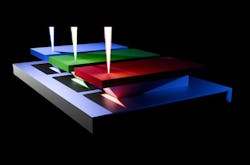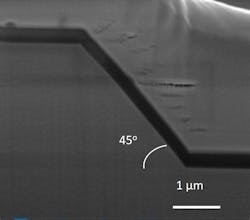Horizontal-cavity surface-emitting superluminescent diodes boost image quality for AR/VR
A team from Vivid Photonics—a spinoff of Tyndall National Institute and the Research Ireland Centre for Photonics—has developed horizontal-cavity surface-emitting superluminescent diodes (SLDs) to significantly boost image quality for augmented and virtual reality applications (see video). These novel light sources combine the characteristics of both lasers and light-emitting diodes (LEDs).
“This is an advance in photonics,” says Muhammet Genc, CTO of Vivid Photonics. “It offers high brightness, broad spectral output, reduced speckle and optical artifacts, and improved scalability.”
How does it work?
SLDs, which operate below the threshold of lasing to provide broadband light emission with high coherence, are ideal for applications—such as holographic and imaging systems—that require broad spectral output, but not the spatial coherence of a conventional laser.
Genc, who is also a researcher in the III-V Materials and Devices Group at Tyndall, says the team paired the SLD with a horizontal cavity architecture. “The device uses a patented architecture with a ridge waveguide to efficiently confine and guide light, which optimizes both emission and carrier injection,” he says.
A 45-degree total internal reflector is included on one facet to redirect light outward. This, in turn, improves emission directionality and eliminates optical feedback within the cavity.
A gallium nitride (GaN) component further enhances the technology because it’s a highly efficient semiconductor material that is ideal for high-power, high-brightness applications—especially for blue and green light sources.
“It is widely used in lasers, LEDs, and now SLDs due to its wide bandgap, high efficiency, and excellent performance at short wavelengths,” Genc says.
What’s so great about it?
The GaN-based horizontal-cavity surface-emitting SLDs tout high brightness, Genc says, with “record-breaking power up to 2.2 W as a benchmark result.” Broad spectral output, reduced speckle, and partial coherence light further bolster the technology that’s also compact, cost-effective, and scalable, thanks to the new surface-emitting architecture.
The Vivid team’s SLD works well for AR/VR applications, specifically aspects such as near-eye projection and holographic displays. Traditional laser-based systems (producing highly coherent light) that are used for holography often suffer from speckle noise, Genc explains, which can degrade the image quality.
“The broad spectral output of our SLD, which produces partially coherent light and minimizes speckle, makes the holographic images smoother and more lifelike,” Genc says.
Another notable advantage is its miniaturization and scalability. The surface-emitting design makes these devices more compact than traditional laser diodes and edge-emitting SLDs, which Genc says allows for easier integration into large-scale display systems and wearables. The design is further optimized with wafer-scale testing and packaging to improve the production process and yield.
“By using multiple ridge waveguides in an arrayed configuration, the devices can efficiently scale power output,” Genc says. “This makes them well suited for high-performance applications that demand both higher power density and a small form factor.”
Next steps
The device currently uses a blue SLD, but the team plans to expand with green and red SLDs to cover the entire RGB spectrum.
“A critical next step will be the seamless integration of these RGB SLDs, along with a compact driver in a mm2 form factor, into real-world near-eye projection and holographic display systems,” Genc says. “The integration process may require the development of advanced optical systems to enhance the coupling of the SLDs to display panels and improve overall performance.”
The team’s ongoing research will focus on optimizing the material properties of the GaN-based SLDs, as well as improving efficiency and extending their operational lifetimes. “Long-term stability and consistent brightness are crucial for practical AR and holographic display systems,” Genc notes.
Scaling up manufacturing processes for mass production at competitive costs is another goal for the researchers as the demand for higher-performance AR/VR systems and holographic displays grows. And Genc says they can go even further—the technology can potentially improve optical imaging systems, such as those used in microscopy, sensing, and other scientific applications that require high-intensity, broad-spectrum light sources.
“These advantages position the technology as the ideal light source for next-generation near-eye projection and holographic displays,” Genc says. “Current challenges of speckle, color reproduction, and miniaturization in projected and generated images are being addressed, with future steps focusing on integration, scaling, and further optimization.”
About the Author
Justine Murphy
Multimedia Director, Digital Infrastructure
Justine Murphy is the multimedia director for Endeavor Business Media's Digital Infrastructure Group. She is a multiple award-winning writer and editor with more 20 years of experience in newspaper publishing as well as public relations, marketing, and communications. For nearly 10 years, she has covered all facets of the optics and photonics industry as an editor, writer, web news anchor, and podcast host for an internationally reaching magazine publishing company. Her work has earned accolades from the New England Press Association as well as the SIIA/Jesse H. Neal Awards. She received a B.A. from the Massachusetts College of Liberal Arts.



